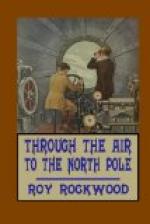“Now we’ll go out on the stern,” he said.
The boys followed as he ascended the companion steps and emerged on a small platform at the rear end of the cabin.
“Do you know what this is?” asked the professor, touching a long, thin, round object.
“Looks like a gun,” replied Mark.
“That’s just what it is. It’s a machine gun that will fire one hundred shots a minute, and it can be turned in any direction, as it works on a swivel. I don’t know that we’ll have any use for it, but I thought I’d take it along.”
Then the professor pointed out where the propeller shaft ran from the engine room out through the stern, and showed how the rudder was worked by wire ropes extending from it to the conning tower.
“In short we have everything necessary to successfully navigate the air,” he went on. “Not a thing has been overlooked. All I have to do is to fill the big bag of oiled silk with a new gas I have discovered and up we go. This is really the most important part of the invention. Without this powerful gas the airship would not rise above the earth.
“But I have found this gas, which can be made in unlimited quantities from simple materials that we can carry with us. The gas has enormous lifting power, and if it was not for that I would not dare make such a large and comfortable airship. As it is, we can sail through the air as easily as if we were on an ocean liner on the sea and much more quickly.
“I generate the gas in the engine room as I need it,” the professor went on. “It goes to the oiled silk bag through two tubes. When we have arisen to a sufficient height I start the electric engine, the propeller whirls around, and the ship moves forward, just as a steamboat does when the screw is set in motion. Then all I have to do is to steer.”
“It’s great!” cried Jack with sparkling eyes.
“It certainly is,” agreed Mark.
From the stern the professor took the boys to the conning tower, where there were several wheels and levers, that placed most of the important machines and engines in the boat under the direct control of the steersman. A lever turned one way would send the ship ahead. Turned in the opposite direction it would reverse the course. A wheel like that on an automobile served to direct the rudder and so guided the Monarch’s course. Other levers controlled the speed of the engines, and the supply of gas that filled the silk bag.
“Here is where we shall carry our supplies of condensed food,” the professor went on, leading the way back into the middle room. “We will take along capsules that will supply us in a small space with meat, vegetables, soups, tea and coffee, besides milk.
“The water we will get as we speed along, dropping down to earth whenever it is necessary. As for clothing, I have an abundant supply.”
He opened a locker and disclosed a pile of fur garments. There were big coats, caps and boots, everything made with a furry surface within as well as without.




